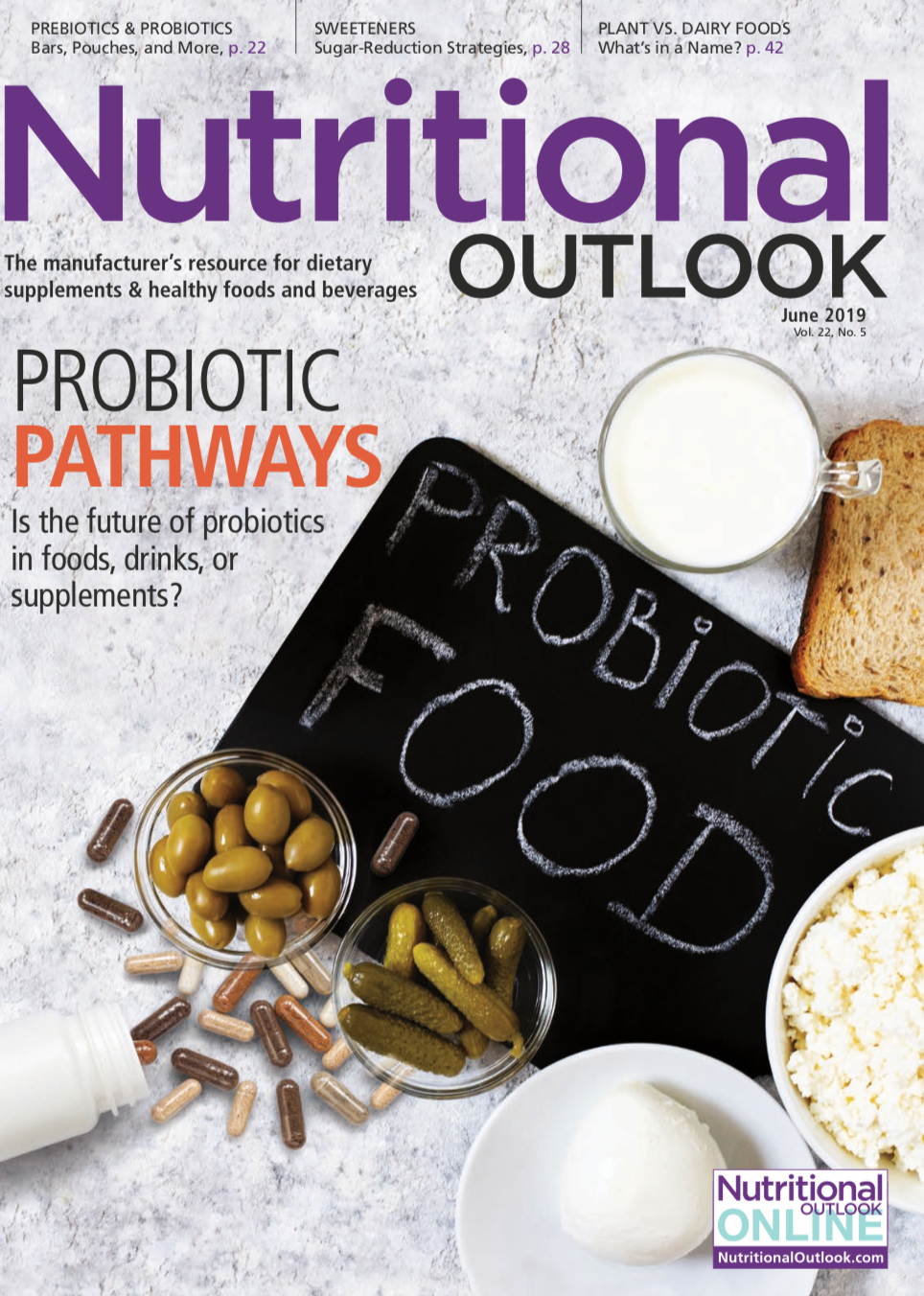Probiotic Pathways: Food, drinks, and supplements. Which is the future?
Does probiotics’ future lie in foods, beverages, supplements-or all three?
Edited by Quinn Williams for Nutritional Outlook. Image Courtesy Daria Mladenovic - Stock.Adobe.com; Image Courtesy Daria Natagolubnycha - Stock.Adobe.com

When Nutrition Business Journal released its latest “NBJ Supplement Business Report,” one datum that stuck out among others-and struck not a little fear into the hearts of industry watchers-was this: probiotic sales growth fell from 17.1% in 2017 to 10.2% a year later, a level far lower than the journal had projected earlier.1
Could it be, pessimists wondered, that this once-powerhouse of a category was on the decline, and that consumers’ fascination with “good gut bugs” had run its course?
Not necessarily. To paraphrase Mark Twain, rumors of probiotics’ death have been greatly exaggerated. For although the growth curve for probiotic supplements may point downward and to the right, probiotic food and beverage sales are looking decidedly up. Indeed, writes Rick Polito in Nutrition Business Journal, “[I]nsider talk suggests the story is more about form and format than a disillusioned consumer…People didn’t give up on probiotics. They just expect them in food and not in a pill.”1
Supplements Here to Stay
Even amidst those shifting expectations, probiotic supplements remain a going concern. Countering the findings of the NBJ report, Sam Michini, vice president of marketing & strategy, Deerland Probiotics & Enzymes (Kennesaw, GA), points to a recent publication from the International Probiotics Association showing that probiotic supplement sales actually grew from 2013 through 2018, “although growth was modest,” he concedes. The organization predicts 26% growth in supplement delivery from 2018 through 2023.
This doesn’t surprise Michini, as probiotic supplements have their advantages. Consider a formulation designed to deliver a higher colony-forming unit (CFU) payload, he suggests. “The dose in supplements typically is more concentrated. Foods generally provide around 1 billion CFU per serving, while a supplement may deliver up to 50 to 75 billion CFU in one capsule.”
And as Barri Sigvertsen, marketing manager, Lonza Consumer Health & Nutrition (Morristown, NJ), adds, “Formulating with probiotics can be challenging.” Humidity, harsh temperatures, and stomach acid all hamper delivery of live and active cultures, and exposure to moisture in packaging can “activate” the bacteria before consumption. “Enhancements in capsule technologies, in particular,” she notes, “enable probiotics to successfully pass through the low-pH environment of the stomach before reaching the intestines, while protecting them from early activation that may result from exposure to environmental humidity.”
Wall of Pills
So three cheers to supplements for supplying a reliable probiotic delivery platform that’s here to stay. Notes John Quilter, vice president and general manager, proactive health, for supplier Kerry’s Ganeden probiotics brand (Mayfield Heights, OH), “The growth in functional foods and beverages hasn’t curtailed the development of the supplement market.”
But, he continues, “We’re seeing more demand for probiotic consumption in easy formats. So consumers are looking for probiotic-formulated foods and beverages throughout the day, whether at breakfast, lunch, dinner, or even a snack.”
Chalk it up to another symptom of pill fatigue. “An increasing number of consumers are turned off by the wall of supplement pills and are on the lookout for innovative products that deliver benefits they consider to be in tune with their lifestyles,” Quilter points out. “Products that can meet that demand will resonate.”
GlobalData research shows that 85% of consumers prefer to consume health-enhancing ingredients through food or beverages, Quilter notes.2 “And the more mainstream functional foods and beverages become, the more likely consumers of all ages will look for products formulated with probiotics.”
It Started with a Spore
They have a lot of options to look for. As Quilter explains, “Probiotics debuted commercially in dairy products, and there’s still a close association with that category. Yogurt in particular remains a standard-bearer, with more than half of all yogurts sold being fortified with probiotics.”3
But thanks to the emergence of “robust, spore-forming probiotic strains,” manufacturers can formulate probiotics successfully into a wide range of nondairy products, Quilter says. The endospores these bacteria wrap around themselves naturally protect them from environmental threat, and suppliers’ ability to harness that spore-forming capacity through “novel technological approaches has completely transformed the probiotic scene,” Quilter contends. “It’s a big step forward.”
Colonizing New Ground
Spore-formers like his company’s GanedenBC30, a patented strain of Bacillus coagulans GBI-30, 6086, resist the extremes of pH, heat, cold, shear, and pressure associated with food production and packaging-not to mention with the human digestive tract-better than do vegetative probiotic cells, “making them a better fit for fortification of everyday foods and beverages,” Quilter continues.
Stability against HTST and HPP pasteurization “opens up new avenues of innovation because it means the ingredient can be used not just in chilled dairy, but in applications like nondairy beverages, frozen foods, cereals, baked goods, better-for-you snacks, and even hot drinks,” he adds. In-application shelf life for his company’s bacteria can be as long as three years.
Michini notes that his company’s Bacillus subtilis strain DE111, a probiotic spore, also survives passage through the digestive tract and remains viable under a range of temperatures and pH levels encountered in foods and beverages. “In stability testing, DE111 experienced virtually no loss of colony-forming units over 24 months when stored at room temperature, 25°C,” he says.
A “great example” of a groundbreaking application is soda, he says, “which is getting much healthier.” Live Soda, for instance, bills itself “The Probiotic Soda Company.” The product is sugar- and calorie-free and promises more than 1 billion CFU of probiotics per 12-oz can-and it contains DE111.
In 2018, Deerland launched a highly soluble version of its flagship probiotic designed for easy incorporation in “high-growth natural-product sectors” like hot beverages, functional drinks, and nutritional-supplement gummies, Michini adds. The ingredient mixes easily with liquids and maintains a high CFU count in the finished product.
Know Your Limits
Despite the significant application ground that hardy spore-formers have broken, obstacles to probiotic food and beverage formulations remain.
“Strains and species have their own unique characteristics,” Michini notes. “For example, there are manufacturing limitations with lactobacilli, which are pretty-much restricted to refrigerated and frozen products. Additionally, hydro-activity in processing can cause Lactobacillus to die off, necessitating significant overages to back up CFU live-delivery claims.”
Sigvertsen agrees. “When developing probiotic products, the key challenges are supporting optimal shelf life and stability,” she says. And here, supplements like capsules have an advantage. With their low water content-4%-6% at 50% relative humidity, or less than 9% over the shelf life without protective packaging, versus 13%-16% for hard gelatin capsules-her company’s hydroxypropyl methylcellulose (HPMC) DRcaps protect probiotics against the depredations of formulation and environmental moisture.
With more gellan-gum gelling agent, they “allow for acid-resistant properties that delay the capsule’s dissolution in the stomach’s acidic environment,” she says. They also modify release to promote complete dissolution in the intestines. “An unpublished independent in vivo gamma scintigraphy study completed in 2013 by Bio-Images Research in Glasgow, Scotland, showed the capsules begin to release in a mean time of 52 minutes after ingestion and when they were about to leave the stomach,” she adds.
In fact, Sigvertsen considers capsule delivery superior to functional foods and beverages not only because of their stability and shelf life, but because of their convenience, ability to mask taste and aroma, and formulation flexibility. Case in point: “Many probiotic supplement launches now feature prebiotics,” she says. “Formulating such combination products is challenging, but probiotic supplementation via capsules offers a unique solution: an internal barrier to prevent water penetration and ensure the stability of the probiotic.”
The inner capsule in her company’s DUOCAP capsule-in-capsule platform typically contains a probiotic, “which is suspended in a solubilized prebiotic formula that’s released first when the outer capsule dissolves and helps feed the probiotic’s growth,” she explains. “The inner capsule with the probiotic cultures dissolves later, improving its ability to reach the intestinal tract.”
People’s Choice
Quilter notes that shelf-stable beverages have proven a consistently tricky application for his company’s spore-former-but that Ganeden’s partners have leveraged cap dispensers and straw technologies as a workaround to deliver an efficacious dose.
Their success gives lie to the notion that supplements’ worth is as a backup platform for when food or beverage delivery fails; on the contrary, Quilter believes, supplements’ worth is in “the importance of offering consumers choice.”
“It’s a case of ‘build it and they will come,’” Michini says. “We feel that although there will be significant development of novel probiotic-containing foods and beverages, this category will also witness strong supplement growth. So all three-foods, beverages, and supplements-will enjoy relevance and consumer loyalty.”
References:
- Polito R. “NBJ Supplement Business Report: Mostly clear skies for supplement industry.” Nutrition Business Journal/New Hope Network. Published August 1, 2018. https://www.newhope.com/market-data-and-analysis/nbj-supplement-business-report-mostly-clear-skies-supplement-industry
- GlobalData. Global Consumer Survey. Q4, 2017.
- MarketsandMarkets. Probiotic Market report. September 2017.

Prinova acquires Aplinova to further increase its footprint in Latin America
April 7th 2025Prinova has recently announced the acquisition of Brazilian ingredients distributor Aplinova, which is a provider of specialty ingredients for a range of market segments that include food, beverage, supplements, and personal care.



















